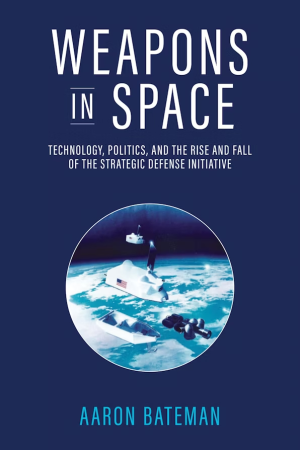An Author Responds to a Review of His Book
September 2024
By Aaron Bateman
Author of Weapons in Space: Technology, Politics, and the Rise and Fall of the Strategic Defense Initiative

The review of Weapons in Space in the July/August issue of Arms Control Today does not address the core arguments of my book. Weapons in Space is an academic history that situates the Strategic Defense Initiative (SDI) within a broader transformation in the military uses of space that began in the 1970s. The book is also the first academic history of space arms control in the late Cold War and explains why space arms control failed, in stark contrast to nuclear arms control at that time. Moreover, the book uncovers the political and technological reasons why U.S. allies participated in SDI, thereby illuminating the international dimensions of controversy surrounding military space activities in this period. Critically, it explains the origins and evolution of SDI, but does not defend SDI.
A central argument of the book is that SDI emerged from intensifying military space competition in the 1970s. As détente crumbled in that decade, the Soviet Union and the United States were developing anti-satellite (ASAT) weapons designed to attack space systems. Both countries sought the ability to destroy satellites that were increasingly important for military applications, such as enabling precision strikes against adversary forces. Nevertheless, there were concerns about the implications of ASAT weapons systems for stability and conflict escalation. In the late 1970s, Moscow and Washington entered into ASAT weapons arms control negotiations that ultimately were unsuccessful. These developments did not make SDI inevitable, but they are key parts of its origin story.
Histories of Ronald Reagan’s presidency frequently cite nuclear abolitionism as a core reason why he pursued SDI. In contrast, the book shines a spotlight on the place of SDI within Reagan’s broader space policy. Reagan had concluded that Moscow was waging a campaign for space superiority, and he sought to expand U.S. military power in space. Yet, he also believed that SDI was a mechanism for eliminating nuclear weapons, a view not shared by Reagan’s advisers. Reconciling Reagan’s rhetoric of SDI as a tool of peace with the reality that SDI technologies could be used offensively was no easy task for his administration.
Weapons in Space further reveals how U.S. allies shaped SDI. Many were skeptical that SDI technologies were feasible and worried that the program would lead to a space arms race. Although many allies and partners became involved in SDI research, several of them continued to oppose deployment of space-based defenses. Analyzing the role of allies in SDI underscores that the expanding militarization of space in this period was an international phenomenon that transcended the bipolar superpower competition.
The consequences of the linkage between SDI and ASAT weapons technologies are especially important from an arms control perspective. As the book shows, due to this relationship, Reagan would not accept any constraints on U.S. freedom of action in space. Despite his public commitment to field ASAT weapons systems, the book reveals that he was willing to trade them away until his advisers explained that doing so would constrain the eventual deployment of missile defense interceptors in space.
In the end, space-based missile defense was not deployed for technological and political reasons. The book details the multiple failures of space-based interceptor tests in 1990 and 1991 that undermined the cause of SDI promoters. Even more importantly, improving U.S.-Soviet relations and progress in nuclear arms control called into question the arguments in favor of continued investment in space-based defenses. Consequently, Congress tightened the purse strings, and President Bill Clinton eliminated space-based interceptors. In this context, momentum for space arms control also waned.
In a counterfactual world, it is unlikely that a space arms control treaty, including limits on SDI, would have prevented the complex space security challenges in the post-Cold War era. Yet, such an agreement would have provided a valuable precedent for current international efforts to reduce risks in space.
